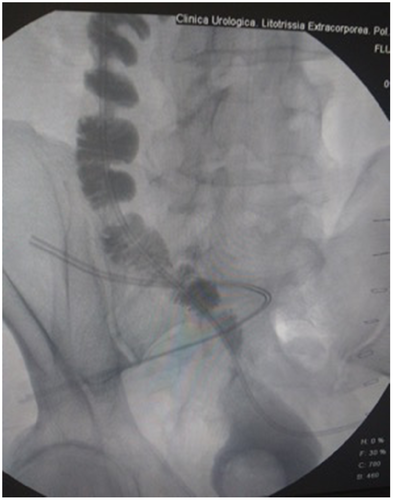Immediate ileal ureter replacement for ureteral avulsion during ureterescopy
Abstract
Introduction
Complete ureteral avulsion represents a rare and fearsome complication of ureteroscopy, reported in less than 1% of cases. In literature there are few reports and different options are presented for its treatment. We present a case of a ureteral avulsion managed with ileal ureter replacement.
Case presentation
A 67-year-old man with a left proximal ureter stone was treated at our department with ureteroscopy. During retrieval of the instrument a complete ureteral avulsion was discovered, with a so-called “scabbard lesion”. We decided to proceed with immediate laparotomy and we performed a ileal ureter replacement.
Conclusion
Ureteral avulsion is a rare complication but must be known as a possible complication in high volume center. There is no standard definition regarding its treatment, and in our experience immediate treatment with ileal ureter replacement proved to be safe and effective without any changes in renal function.
Abbreviations & Acronyms
-
- NA
-
- not assessed
-
- SWL
-
- shock wave lithotripsy
-
- UCNS
-
- ureterocistoneostomy
-
- UPJ
-
- ureteropelvic junction
-
- UVJ
-
- ureterovesical junction
Keynote message
Even if rare, ureteral avulsion must be known as a complication of endoscopic surgery and its management could be challenging.
Introduction
Increased technology has reduced complication rates of ureteroscopy, however, even if a specific classification is lacking, the rate of complications ranges from 0 to 28%.
Among these, iatrogenic ureteral injuries vary from minor mucosal petechiae to erosion, perforation, false routes, and rarely, complete ureteral avulsion.1, 2
The term ureteral avulsion refers to the discontinuation of the full thickness of the ureter and has been firstly introduced to describe an upper urinary tract injury after blunt trauma or due to stone basketing procedures.3
We present a case of complete ureteral avulsion during ureteroscopy, treated with immediate surgical intervention and ileal ureter replacement.
Case presentation
A 67-year-old man presented to our Clinic for a 10 mm right proximal ureter stone and with a nephrostomy tube inserted 1 week before in another hospital for recurrent colicky pain not responsive to painkillers.
He has a history of calcium oxalate stone disease and he underwent multiple SWL treatments for other stones and even for the same ureteral stone 2 weeks before.
After discussion of the therapeutic options we decided to perform a semi-rigid ureteroscopy to treat the stone. After a retrograde pyelography that showed a stop of contrast progression at the level of the stone, a hybrid guidewire (Ultra-Track; Olympus, Hamburg, Germany) was positioned in the renal pelvis above the stone. A 8 Ch semi-rigid ureteroscope (Karl Storz Endoscopy, Tuttlingen, Germany) was inserted into the right ureter alongside a second wire in the working channel according to the “railway” technique.
We noticed some friction at the level of the UVJ that was hardly overcome by the instrument. The lumen of the ureter just below the stone was narrow and the ureteral mucosa was pale and rigid; the instrument maneuverability was reduced because the ureteroscope was tightly wedged in the ureteral lumen; we decided to try with a flexible ureteroscope or eventually to place a JJ stent. The safety guidewire was left inside, but when the scope was pulled out, we noticed that the avulsed ureter was covering the ureteroscope as a scabbard. We performed an antegrade pyelography that confirmed that the total ureteral avulsion occurred just below the UPJ. After an accurate surgical consultation with all the surgical staff and an adequate discussion with the patient’s relatives, we decided to proceed with laparotomy in the same session with the aim of an immediate ureteral reconstruction. We found out a complete avulsion, with a lesion at the level of the UVJ and another one at the proximal ureter where the stone was located. We noticed that remaining ureter was too short to perform a reimplantation and after a having checked the integrity and the normality of the ileum, we decided to proceed with ileal ureter replacement.
A terminal ileum loop 20 cm away from ileocecal valve was isolated. A 20 cm segment was transected and the continuity of ileum was restored with a GIA™ stapler (Medtronic, Minneapolis, MN, USA).
The proximal end was then anastomosed to the renal pelvis after placement of a JJ stent and the terminal end, in an isoperistaltic fashion, was brought down and a direct end-to-side ileal-bladder anastomosis was realized, after having performed a bladder psoas hitching to reduce the tension of the anastomosis.
Post-operative course was uneventful and after 7 days we performed an antegrade pyelography (Fig. 1) and removed the nephrostomy. The patient was discharged in postoperative day 10 and the JJ stent was removed 6 weeks after surgery without any complication.

We follow-up the patient with a computed tomography scan after 3 months that showed no hydronephrosis and a good excretory phase. After 9 months the patient underwent a renal scintigraphy which was completely normal. One year after surgery the patient has not had any infections and serum creatinine remain stable. We decide to keep following-up him with a renal ultrasound once every 3 months and a renal scintigraphy after 1 year.
Discussion
Ureteral avulsion is a rare but serious complication of ureteroscopy. Despite its low incidence, it is important to be aware of this complication because inappropriate management could lead to nephrectomy.
Determinant mechanism of the lesion is multifactorial but some risk factors are described: proximal stone location, previous SWL treatment as proved by Fuganti et al.4
Gotkas et al. showed there is a higher urine inflammatory cytokines level after SWL5 with an increased inflammation and fragility of the ureter.
Furthermore, the presence of symptoms for more than 3 months, stones above the ischial spines, stones >5 mm in width, a dilated proximal ureter, and involvement of a less expert urologist were factors associated with a statistically significantly higher incidence of intra-operative complications.6
There is not any general rule for optimal management of ureteral avulsion and different reports have been published with conflicting results (Table 1).
| Ureteral lesion | No. cases | Technique of reconstruction | |
|---|---|---|---|
| Meng et al.9 | UPJ | 3 | Autotransplantation |
| Stein et al.10 | UPJ and UVJ | 2 | Ileal ureter replacement (1 open, 1 laparoscopic) |
| Alapont et al.11 |
Proximal ureter Mid ureter |
3 |
1 UCNS with Boari flap 1 nephrectomy 1 repositioning, ended with nephrectomy 3 months later |
| Sevinc et al.6 |
2 distal ureter 1 total ureter |
3 |
2 UCNS + psoas hitch 1 ileal ureter replacement |
| Ordon et al.12 | Proximal ureter | 3 | Nephrectomy |
| Taie et al.13 |
UVJ in 1 patient UVJ and UPJ in 5 patients |
6 |
1 simple UCNS 2 Boari flap 1 ileal ureter replacement 2 nephrectomy (1 after initial double ureteral anastomosis) |
| Unsal et al.14 | UVJ and UPJ | 4 | 2 double anastomosis for male patients, 2 double anastomosis with Boari flap for two female patients (1 ended with renal atrophy) |
| Ge et al.15 |
1 UVJ and UPJ 1 3 cm above UPJ 2 distal ureter |
4 |
Double anastomosis (nephrectomy after 11 months) Autotransplantation 2 UCNS |
| Tsai et al.16 |
UPJ Proximal ureter |
2 |
End-to-end anastomosis Retroperitoneal transureteroureterostomy |
| Martin et al.17 | UPJ | 4 |
1 autotransplantation 1 ileal ureter replacement 1 UCNS with bladder psoas hitch 1 Boari flap |
|
Georgescu et al.18 |
N.A. | 3 |
1 nephrectomy 1 end-to-end anastomosis 1 Boari flap |
In the management of ureteral avulsion there are different factors to take into account: age of the patient, comorbidity, previous surgery, renal function, degrees of tearing and length of the ureter, and even surgeon’s experience and centre facilities.
Different “conservative” management are described in literature but whenever a repositioning is attempted, there is a high risk of stricture and renal failure in long-term follow-up with an increase risk of subsequent nephrectomy.6, 7
Autotransplantation is described as an alternative particularly in young patients. In elderly people and without any specific study of the vascular anatomy, the choice of autotransplantation must be evaluated only as a delayed, elective procedure in “high volume” center.
Appendix interposition has also been reported as a treatment option for extensive injuries in some literature reports8 but it is suitable for short defect.
Ileal ureter replacement is a type of reconstructive surgery routinely performed in our department for long ureteral strictures or for ureteral cancer in which conservative treatment is mandatory.
Even if the patient did not undergo any type of bowel preparation, it has been largely demonstrated for reconstructive surgery in bladder cancer and for colorectal surgery that bowel preparation is not necessary and does not give any advantage when the ileal segment is used.
Considering patient’s age, his normal renal function, and our experience, we decided to choose this immediate reconstructive intervention that has been shown to be a safe option for the patient even in the long term.
Conflict of interest
The authors declare no conflict of interest.




